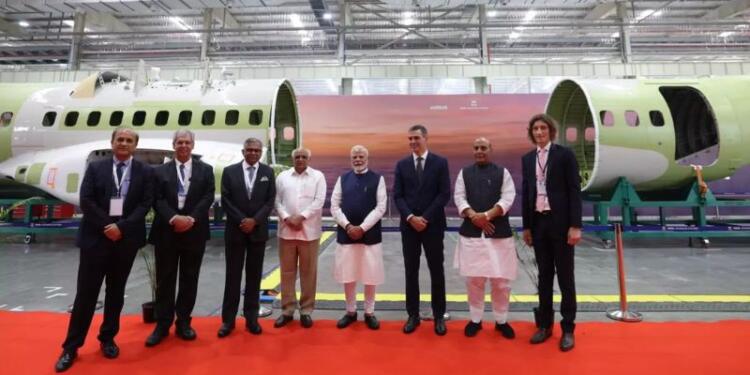India joins a select global club of countries that can roll out military aircraft through private sector participation in aerospace manufacturing. It makes a reality, the dream of “Make in India, Make for the World”.
Prime Minister Narendra Modi and his Spanish counterpart Pedro Sanchez inaugurated the country’s first private military aircraft plant in Gujarat at the Tata Aircraft Complex this week.
The country will now manufacture Airbus C-295 transport planes for the Indian Air Force in partnership with Airbus Spain.
The C295 will replace the aging Avro fleet of the Air Force. It is a transport aircraft with a 5 to 10-tonne capacity and a maximum speed of 480 kmph. It has a rear ramp door for quick reaction and para-dropping of troops and cargo. Short take-off and landing from semi-prepared surfaces are some other features.
PM Modi sees it as yet another push to his Make In India call to eventually make India a formidable manufacturing hub in the world.
In the military aviation sector, the Tata complex will be a “magnet for investment and business-to-business collaboration”.
His aspiration: “This partnership between Airbus and Tata will contribute to the progress of the Indian aerospace industry and will open new doors for the arrival of other European companies.”
India signed a €2.3 billion deal with Airbus Spain in 2021. It involves delivering 16 aircraft from Spain, six of which have been delivered to the Indian Air Force so far. Tata will produce 40 more in Vadodara, with India’s first C-295 expected in 2026.
Possibly, the 32nd aircraft, which is scheduled for delivery in the first quarter of 2029, will be nearly a fully Indian C295.
The Gujarat aviation manufacturing model represents the government’s stress on promoting private defence production and easing foreign investment rules. This plant reflects Modi’s vision to modernise India’s defence sector.
So far, the state-owned Hindustan Aeronautics Limited (HAL) has had a monopoly over the manufacture of military aircraft in India.
This will boost India’s aerospace sector with 15,000 high-skilled jobs and 10,000 indirect jobs in the next 10 years.
After the completion of the delivery, Airbus Defence and Space will be allowed to sell the aircraft manufactured in India to civil operators and export to countries that are cleared by the Indian government.
All 56 aircraft will be fitted with an indigenous electronic warfare suite to be developed by Bharat Electronics Ltd and Bharat Dynamics Limited. Experts say the Indigenous content in the plane will be the highest ever in India, and that 96 percent of the work that Airbus does in Spain to produce the plane will be done at the manufacturing unit in Vadodara.
The new manufacturing facility in Gujarat will push India’s defence capabilities. The project will involve the full development of a complete ecosystem from the manufacture to assembly, testing, and qualification, to delivery and maintenance of the complete lifecycle of the aircraft.
Besides Tata, defence public sector majors like Bharat Electronics Ltd. and Bharat Dynamics Ltd., along with private MSMEs, will contribute to creating a comprehensive ecosystem for military aircraft production in India.
The project will promote the growth of ancillary sectors, including those involved in manufacturing components and providing services. The manufacture will simultaneously involve the establishment of comprehensive training and maintenance infrastructure, maintenance facilities, and supply chains for spare parts.
The manufacturing plant will offer a unique opportunity for the Indian private sector to enter the technology-intensive and highly competitive aviation industry. It will augment domestic aviation manufacturing resulting in reduced import dependence and expected to increase in exports.
According to government officials, 13,400 parts, 4600 sub-assemblies, and all significant component assemblies will be manufactured by 25 domestic MSME suppliers spread across seven states. The aircraft coming out of the plant will be fitted with an indigenous electronic warfare suite developed by Bharat Electronics Ltd and Bharat Dynamics Limited.
The Gujarat plant comes at a time when India is taking off to become the world’s aviation hub in the next decade. Its aviation industry has experienced significant growth in the last decade. The number of operational airports in the country has doubled from 74 in 2014 to 157 in 2024 and the aim is to increase this number to 350-400 by 2047. India’s ambition is to become the third-largest aviation market globally.
The Indian government’s initiatives and reforms, including the National Civil Aviation Policy and the UDAN scheme, are tuned to this goal. The Gujarat plant, thus, rubs off positively on the civil aviation sector as well.
In 2023, Primus Partners, a consultancy firm, brought out a report listing the steps India needs to take in several key industry sub-sectors to reach the status of aviation hubs like Singapore, Dubai, or Doha.
The Tata complex should encourage other private actors to enter the civil aviation sector. For, as the report says, a critical factor driving India’s aviation growth is fleet expansion. Indian airlines are preparing for future demand by placing large aircraft orders with manufacturers like Boeing and Airbus. The country’s aircraft fleet is projected to grow from 713 in 2022 to 1,647 by 2032. This substantial increase will enable India to not only meet its growing domestic demand but also enhance international connectivity.


































